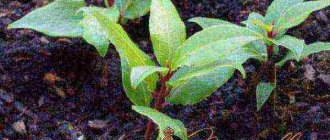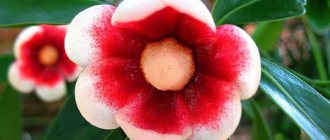Author: Natalya Category: Houseplants Published: February 19, 2019Republished: February 20, 2019Last edits: January 11, 2021
- Orange ginura (Gynura aurantiaca)
- Properties
The ginura flower (lat. Gynura) belongs to the genus of plants of the Compositae family, which, according to various sources, numbers from 47 to more than 100 species. They grow naturally in the tropics of Asia and Africa. Translated from Greek, ginura means “woman with a tail” - apparently, they meant the long lashes of the plant. Today, some types of ginura are grown in cultivation as ornamental indoor plants.
Planting and caring for ginura
- Flowering: from spring to late autumn.
- Lighting: bright light - western or southern window sills are suitable, but with shading in the afternoon. In winter, the plant needs additional artificial lighting.
- Temperature: during the growing season – 18-24 ˚C, during the dormant period – 12-14 ˚C.
- Watering: abundantly, as soon as the top layer of the substrate in the pot dries. If the plant is in a cool room in winter, reduce watering.
- Air humidity: any, but if heating devices are used indoors in winter, keep the plant on a tray with wet pebbles. Spraying the leaves is not recommended.
- Feeding: during the growing season twice a month with complex mineral fertilizer. During the dormant period, no fertilizing is applied.
- Dormant period: winter.
- Replanting: in the spring as needed, but an adult plant should be rejuvenated by replanting every two years.
- Reproduction: cuttings.
- Pests: scale insects, aphids, spider mites, mealybugs and whiteflies.
- Diseases: root rot.
Read more about growing ginura below.
Diseases and pests
Gynura's pests are whiteflies, spider mites, aphids, mealybugs and feltworms. Mealybugs cause spots on leaves due to insect secretions. The flower begins to grow slowly.
Spider mites feed on the sap of the subshrub, which leads to weakening and further death. You can understand the presence of a pest by the corresponding web on the branches and foliage.
Aphids also feed on ginura juice. The insect is located on the underside of the leaves. At the same time, sticky drops appear on the surface.
The whitefly is easy to detect - small white flies begin to fly around the flower. Their appearance is characterized by the presence of a sticky layer on the surface of the shrub. Over time, the foliage turns black, curls, and the plant dies.
It will not be possible to get rid of insects by washing the leaves, since the flower is characterized by increased pubescence. Therefore, it is necessary to treat with appropriate insecticides (confidor, talstar, kleschevit, actellik).
If not properly cared for, the ginura gets sick and the following problems arise:
- Loss of purple color. If the leaves fade, it is better to place the bush in a brighter place.
- Loss of decorative appearance during flowering. The plant spends a lot of energy on the development of flowers, so it is recommended to tear off the buds.
- The appearance of black spots on the leaves. The cause of the defect is water getting on their surface.
- Drooping shoots. The plant is “old” and needs to be renewed.
Botanical description
The ginura plant is an evergreen perennial subshrub or herb with creeping stems reaching several meters in length. The roots of ginura are tuberous or fibrous, the stems are fleshy, lignified with age, bare or pubescent. The leaves are alternate, simple, collected in a rosette or stem, petiolate or sessile, fleshy or thin, sometimes pubescent, sometimes not. The undersides of the leaves of some species are purple in color. The shape of the leaves is oblong-lanceolate, elongated, ovoid, deltoid or lyre-shaped. The teeth along the edges of the leaves can be small or large.
The flowers are solitary or collected in axillary or terminal corymbose panicles and are yellow, red, purple or orange. Under natural conditions, ginurs bloom almost all year round, and their flowering is especially abundant from December to early summer. Since the flowers of the plant emit an unpleasant odor, some gardeners cut off the ginura buds.
In home culture, mainly such plant species are grown as orange ginura, climbing ginura, ascending ginura and hybrid variegated ginura. Ginura grows very quickly; some of its species are grown as an ampelous plant. It is worth knowing that ginura species grown at home are poisonous, so when caring for these plants, take safety precautions and keep them away from pets.
- Cocklebur: cultivation, properties, types and varieties
Care
Care after purchase
Ginura wattle is unpretentious
and not particularly demanding. She loves good light, and if there is a lack of light, the leaves will fade.
It is better to place the plant on windows facing west or east. When placed on a southern windowsill in summer, it is better to shade the flower. It is better to accustom ginura to bright light gradually
: Do not deprive it of sunlight, but place it away from the window. Gradually move the pot closer to bright light.
Trimming
The main problem of the wattled ginura is rapid growth and elongation
. To maintain the lushness of the foliage, it is necessary to pluck the tops of the shoots, then the lateral ones will develop much better.
Thanks to the long shoots, you can shape the crown to your taste. You can design the plant in the form of an arch by bending the wire into an arc and placing it along the edges of the container
The arch should be carefully braided with shoots and, if necessary, secured with threads in several places
Watering
From the beginning of spring, the flower must be watered very abundantly.
, but be sure to wait until the top layer of soil dries. The plant loves good air humidification, so you should spray the area around the plant, without getting it on the leaves because of the possible appearance of spots on them.
You can place the container with the flower on a tray filled with water or damp moss. Water from the pan should not rise into the soil. Some people put pebbles
and add a small amount of water.
IMPORTANT! In winter, the plant needs moderate watering. It is undesirable to allow dehydration, as the ginura will begin to shed its leaves.
Once every 3 weeks, the flower can be fertilized with a special complex solution
. This applies to the spring and summer periods. In winter, one feeding every month and a half is enough.
Planting and transplanting
Ginura wattle requires annual replanting, the preferred time is spring
. Before the procedure, water the flower intensively.
Then we begin to fill the drainage system into a new pot with a large volume. We place a layer of turf soil on the drainage. You can purchase a ready-made substrate for hanging plants.
Ginura should be carefully removed from the old pot without damaging the shoots. The root system should be cleared of old soil. Then the plant needs to be lowered into a new container and the roots covered with a new substrate.
To activate the root system, the transplanted flower must be placed in a shady place
. It is better not to water the ginuru for a couple of days. After adaptation, the flower can be placed on the windowsill.
Growing
Despite the fact that Ginura vinata is considered a perennial plant, it is rarely kept for more than two years, since over time the color of the foliage begins to noticeably fade. An adult ginura does not tolerate wintering well compared to a young one. When deciding to leave a flower for a long time, you need to prepare for the fact that you will have to regularly trim an adult flower to propagate the plant or take cuttings
his.
Reproduction
Ginura wattle is propagated by cuttings and seeds
.
10 cm long is cut off from an adult flower.
. There must be healthy leaves. The cut is treated with a special rooting preparation. We plant the cuttings in a small container with a drainage system at the bottom.
The substrate is prepared from turf mixed with sand, preferably coarse-grained. Next, you need to water it well and cover the cutting with a bag. Remove the bag every day for 5 minutes. The soil should always remain moist. The ginura is transplanted into a permanent container after three weeks.
REFERENCE!
Some gardeners root the vine plant in water.
Temperature
This plant does not like too warm air at all. In spring and summer, it is better to keep ginura at a temperature of 20-23 degrees
.
In winter, it is best to provide rest to the flower to preserve its appearance. During this period, you should place the pot with the plant in a cool room with a temperature of 12-15 degrees
.
If you leave the wicker plant in a warm room in winter, the decorative qualities of the flower will disappear.
In spring, it is better to take the plant out onto the balcony or into the garden. You can transplant ginura into open ground for the summer.
Ginura care at home
Growing conditions
How to grow ginura in an apartment? The indoor flower ginura loves bright light - the plant needs it to maintain its rich color. The best place for a ginura will be a windowsill with a western or southern orientation, but it must be taken into account that for several afternoon hours, when the sun is especially merciless, even the ginura will need shading. In winter, when daylight is short, you will have to install additional lighting for the ginura.
The optimal soil for ginura is a substrate consisting of equal parts of turf and leaf soil and humus with the addition of half a part of river sand. You can prepare a different composition for the plant, the main thing is that the soil is loose, permeable and neutral.
In summer, the domestic ginura prefers a temperature of 18-24 ºC, and in winter, if you cannot provide it with artificial lighting, keep it in a room with a temperature no higher than 12-14 ºC so that it can rest. If you install a phytolamp near the gynura, the temperature does not need to be lowered.
During the period of active growth, caring for ginura at home involves abundant watering - water it as soon as the top layer of soil in the pot dries out. In winter, if the plant is resting in a cool place, watering should be reduced, otherwise excess moisture will lead to waterlogging of the soil and rotting of the roots. If the plant’s daylight hours are organized as in the summer, and the temperature in the room is summer, then watering remains the same as during the growing season. Water the ginura with soft water that has stood for at least a day, trying to ensure that drops of water do not fall on the leaves of the plant.
Indoor ginura is undemanding when it comes to air humidity, but in winter, when heating devices are on, the air in the room is too dry, so it is advisable to place ginura on a tray with wet expanded clay or pebbles. It is not recommended to spray ginura leaves with water, as the plant may lose its decorative properties.
Caring for ginura requires pruning - it needs to be tidied up after winter. In addition, pruning stimulates bushiness and rapid growth of ginura shoots. Just pinch off the tops of the ginura stems, that's the whole procedure.
- What tradescantia looks like (photo)
Ginura plant care includes fertilizing with complex mineral fertilizer twice a month during the growing season. When ginura is in a dormant period, it does not need fertilizers.
Ginura is replanted as needed in the spring. The fact is that only young plants have a beautiful purple tint of leaves, so it is advisable to rejuvenate adult ginura every two years by replanting.
Reproduction of ginura
Ginuru is propagated mainly by cuttings - this is the easiest way to propagate a plant. In spring and summer, it is enough to break off the apical cutting with two internodes and put it in water - after two weeks the cutting will form roots and it can be planted in the ground.
Pests and diseases
Ginura is very resistant to diseases, but with improper or insufficient care, uninvited guests can settle on it - scale insects, aphids, mealybugs, whiteflies and spider mites.
Scale insects - these insects stick to the leaves of the plant and feed on their juice, as a result of which the leaves quickly turn yellow, fall off, the ginura stops developing, lags behind in growth, begins to dry out and eventually dies. Treat the ginura with Actellik solution and, if necessary, repeat the treatment after a week.
Whiteflies are miniature white moths that lay eggs on ginura leaves. In the fight against whitefly, the drugs Actellik, Mospilan, Fufanon, Fosbecid and Confidor are used.
Mealybugs, or hairy lice, are sucking insects that feed on plant cell sap. They are called mealy plants because of their waxy, cotton-like secretions that they leave on the leaves and stems. A plant occupied by scale insects is stunted in growth, and some types of pests can even infect the root system of the ginura. In the fight against mealybugs, the drugs Aktara, Mospilan, Fitoverm, Calypso, Biotlin have proven themselves well.
- Photos of calceolaria species
Spider mites are pests that attack any plants except aquatic ones. Ticks, like scale insects and scale insects, feed on plant sap. Their presence can be detected by small white dots on the underside of the leaf blade and a thin, almost invisible web. The harm of ticks is not only that they drink juices from ginura, but also that they are carriers of viral infections, for which there is no way to cure the plant. The drugs Agravertin, Actellik, Kleschevit, Fitoverm, Akarin and Oberon destroy ticks.
Aphids - this ubiquitous pest is also a sucking insect and is also a carrier of viral diseases. You can get rid of aphids by repeatedly treating ginura with the same drugs that are effective against spider mites.
How to create an optimal microclimate depending on the season?
Like many plants, ginura has a dormant period. Therefore, the required conditions depending on the season differ slightly, but still differ. The flower is undemanding to air humidity; the main attention should be paid to proper watering.
Table: how to care for a plant depending on the season
| Parameter | Winter | Summer |
| Lighting | Bright diffused light. In most of Russia, there is not enough natural lighting, so you will have to use fluorescent or special phytolamps. | East or west window. Ginura will not grow in the back of the room or on the northern window. |
| Air temperature | 16–18°C. The lower limit is 15°C. | 20–24°C. Although, in principle, ginura will tolerate any heat without much damage to itself. |
| Watering | Approximately once every 5–7 days, only at the root, with the soil drying out by 4–6 cm. | Frequent and sparse, only at the root, with soil drying out by 2–3 cm |
| Feeding | Not carried out. | Universal fertilizer for decorative leafy indoor plants once every 2 weeks. |
| Air humidity | Does not require spraying, tolerates dry air calmly. | Air humidity is not a critical parameter for plant development. In extreme heat, you can place containers of water nearby or place wet moss, pebbles, or expanded clay in a tray. Spraying the flower is strictly prohibited. |
Types and varieties
Not many species of ginura are grown in culture. Most often these are orange, ascending and spiny ginurs.
Orange ginura (Gynura aurantiaca)
An evergreen subshrub up to 1 m high with ribbed, pubescent shoots. The leaves of orange ginura are alternate, the lower ones are ovate, the upper ones are small, pointed, unevenly serrated, petiolate, violet-red. Both the leaves and stem are covered with purple hairs, so the plant appears purple in bright light. Actually, orange ginura is violet ginura. It was named orange for its small golden-yellow or orange flowers collected in baskets. In nature, this species grows on the island of Java.
Gynura sarmentosa
It is similar to orange ginura, but its stems are drooping, which allows it to be grown as an ampelous plant. And in height it is half the size of the orange ginura - no more than 60 cm. The leaves of this plant species are small, up to 7 cm long. The wicker ginura comes from East Africa.
Climbing Gynura (Gynura scandens)
Or Ginura ascendant - a less common plant, often grown in a greenhouse. This is a subshrub with large oval, sparsely toothed leaves. The length of its lashes can reach 2 m. Plants of this species look good in hanging compositions.
Rules of care
Photos of crossandra species, home care
This unpretentious decorative foliage will require a minimum of care
The most important thing is to choose a suitable place where the tropical woman will be comfortable and where she will reveal all her beauty. The website flowery-blog.ru will tell you how to do this.
Temperature and lighting
With good ventilation, ginura can grow even in direct sun. The plant does not like stuffy rooms, which causes the leaves to droop and lose color. The light-loving ginura can decorate a balcony in the summer months, and migrate to the windowsill in the winter. On the south side, shading will be required during the midday hours. The main mistake is placing it in partial shade, where the leaves quickly lose color and the shoots stretch out in search of light.
The range of comfortable temperatures for a flower is very wide. Even the difference in night and day temperatures when kept outdoors in the summer has a beneficial effect, strengthens and tones. It is possible to lower the temperature to 13 degrees without harm to the plant
It is important to take into account that the frequency and abundance of watering depend on the temperature: the lower it is, the less often you need to water the plant
Watering and humidity
Moderate watering guarantees health! Excess moisture in a pot can be dangerous, especially in cold temperatures
It is important that the soil dries out between waterings. 8 rules of watering
It is not recommended to spray all flowers whose leaves are covered with hairs. Since moisture, lingering on the hairs, can provoke the appearance of fungus.
Fertilizers and fertilizers
From spring to autumn, liquid universal fertilizer should be added to the water for irrigation every 2 weeks. Like all decorative foliage plants, ginura prefers nitrogen fertilizing, which plays a key role in foliage growth. But the feeding regimen and dosage should be moderate! Excess nitrogen will lead to discoloration.
Reproduction and transplantation
Propagating ginura is as easy as shelling pears! Its cuttings, obtained after pruning, easily take root in water. They can be planted directly to the mother plant to obtain a fuller bush, or planted separately.
A properly selected flower pot will help you create a beautiful composition. For such a bright plant, it is preferable to choose pots of dark colors: gray, purple, or green. It is better if they are plain pots, without a pattern, and the shape does not matter for the ginura. You can place a flower pot in a beautiful flowerpot to match the interior: wicker or tin.
For the ginura plant, care involves regular replanting. Young specimens grow quickly and require frequent transfer to a larger pot, sometimes even twice during the growing season. Adult varieties are replanted annually. The soil mixture should be loose and breathable, but at the same time nutritious, based on peat, with the addition of turf soil and humus. Ready-made mixtures based on nutritious black soil are also suitable. Review of purchased substrates.
Ginura - signs and properties
Properties
Surprisingly, unlike poisonous species grown indoors, some of the varieties of ginura are medicinal plants, and their healing properties have been known for centuries.
The species Ginura pinnadris is an expensive and rare medicinal plant, which is grown on an industrial scale in one of the Chinese provinces. This type of ginura is widely used in medicine because it contains volatile oils, triterpene saponins, bioflavonoids, polysaccharides, amino acids and trace elements.
The healing plant is Ginura prostrata, well known to the inhabitants of China, America and Japan. Anyone who eats her food practically does not get sick. It gives strength, improves metabolism, helps in the fight against excess weight, lowers blood sugar levels, lowers blood pressure, and cleanses the blood, kidneys and liver of cholesterol. It is enough to consume 2-3 leaves of ginura spread a day in the morning before meals, and within two weeks you will notice an improvement in your general condition. Ginura prostrate leaves can be added to salads, as they taste exactly like this green.
Signs
People call the ginura “crocodile”. Due to the unpleasant smell of its flowers, it is under the sign of Scorpio, but in fact, ginura is good at cleansing the atmosphere of the house from bad energy, saving from nightmares and the fear of the dark. It is believed that the soft leaves of ginura have the ability to soften a person’s rough voice and harsh character. By the way, experts in esotericism claim that the foul-smelling flowers of the plant protect amorous people from mistakes, and therefore they do not recommend plucking them, and the plant, so that it can manifest this property, is advised to be placed in a shaded place.
They also say that ginura in the house is a sign of a woman’s happiness...
Ginura care at home
The exotic culture of ginur needs abundant watering
throughout the entire period of vigorous growth. This phase lasts from early spring until late autumn. Another wetting of the soil is required as soon as the soil layer on top dries. During winter, the ginura has a time of rest. At this time, the plant should be watered moderately, that is, several days after the soil has dried on the surface of the earthen clod. For this purpose, settled, slightly warm water is used.
Also during the growing season, exotic plants need constant feeding. This measure promotes more intensive growth and culture formation. They feed the ginura with a concentrate prepared for flowers growing in the room, or use complex fertilizers. The frequency of their application to the soil under the plant is 2-3 times a month. During winter and autumn, it is recommended to reduce fertilizing to 1 time every 1.5 months.
In the spring, it is best to replant the plant annually or every 2 years. Such regular rejuvenation will make it possible to preserve in an adult specimen the attractive purple hue of the leaves, which is often characteristic of young forms. Also, transplantation technology can be performed if there is a need for this. The substrate is formed from similar elements as the soil for planting; the pH of the soil mixture should not be greater than 6.
It is appropriate to care for ginura by pinching the tops of the stems as they grow. This is done to create a beautiful, lush crown of a subshrub.
Ginura can be propagated in 2 ways: apical cuttings and seeds. The first method is preferable, as it is distinguished by its relative ease of execution. It is necessary to break off part of the shoot, place it in water in a sunny place, maintaining the air temperature within +23?. You can do rooting in any substrate. The roots of the cutting appear after 7-10 days.
The crop is damaged by mealybugs, whiteflies, scale insects, and spider mites. In general, ginuru can be considered an undemanding plant.
Creator: Ponomarenko Nadezhda
The note is protected by copyright and neighboring rights. When using and reprinting material, a strong link to the site for women www.Inmoment.Ru is required!
Tags: ginura, ginura care at home
Propagation of ginura by cuttings
How to propagate ginura from cuttings photo
Ginura is mainly propagated by cuttings. How to root ginura? In spring and summer, break off the apical stalk with two internodes and place it in water. In a couple of weeks the roots will appear, you can safely plant a new plant in the ground.
Cuttings can also be planted directly into the ground, not forgetting to water. The seedlings quickly take root and begin to grow.











